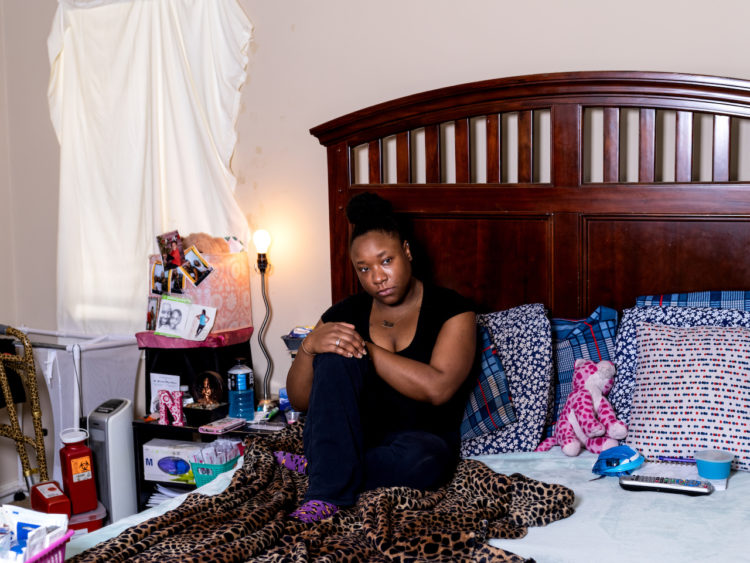India Hardy has lived with pain since she was a toddler — ranging from dull persistent aches to acute flare-ups that interrupt the flow of her normal life.
The pain is from sickle cell disease, a group of genetic conditions that affect about 100,000 people in the U.S., many of them of African or Hispanic descent.
Sitting in the afternoon heat on her mom’s porch in Athens, Georgia, Hardy recollected how a recent “crisis” derailed her normal morning routine.
“It was time for my daughter to get on the bus, and she’s too young to go on her own,” Hardy recalled. “I was in so much pain I couldn’t walk. So, she missed school that day.”
Sickle cell disease affects red blood cells, which travel throughout the body carrying oxygen to tissues. Healthy red blood cells are shaped like plump and flexible doughnuts, but in people with sickle cell disease, the red blood cells are deformed, forming C-shaped “sickles” that are rigid and sticky.
These sickle-shaped cells can cause blockages in the blood vessels, slowing or even stopping normal blood flow. An episode of blockage is known as a sickle cell “crisis” — tissues and organs can be damaged because of lack of oxygen, and the patient experiences severe spells of pain.
‘It’s Like Torture’
Hardy tries to manage these crises on her own. She’ll take a hot bath or apply heating pads to try to increase her blood flow. Hardy also has a variety of pain medications she can take at home.
When she has exhausted those options, she needs more medical help. Hardy would prefer to go to a specialized clinic for sickle cell patients, but the closest is almost two hours away, and she doesn’t have a car.
So, Hardy often goes to the emergency room at nearby St. Mary’s Hospital for relief. Until recently, the doctors there would give her injections of the opioid hydromorphone, which she says would stop her pain.
Then, some months ago, the emergency room changed its process: “Now they will actually put that shot in a bag which is full of fluids, so it’s like you’re getting small drips of pain medicine,” Hardy said. “It’s like torture.”
It’s the same for her brother, Rico, who also has sickle cell disease and has sought treatment at St. Mary’s. The diluted medicine doesn’t give the same pain relief as a direct injection, they say.
Striking a Balance
St. Mary’s staffers explain that they’re trying to strike a balance with their new treatment protocol between adequate pain treatment and the risk that opioid use can lead to drug dependence.
It’s a local change that reflects a national concern. The U.S. is in the midst of an addiction and overdose crisis, fueled by powerful opioids like hydromorphone. That crisis has made medical providers more aware of the risks of administering these drugs. More than 47,000 Americans died in 2017 from an overdose involving an opioid, according to the Centers for Disease Control and Prevention.
That has prompted some emergency room leaders to rethink how they administer opioid medications, including how they treat people, such as Hardy, who suffer from episodes of severe pain.
“We have given sickle cell patients a pass [with the notion that] they don’t get addicted — which is completely false,” said Dr. Troy Johnson, who works in the emergency room at St. Mary’s. “For us to not address that addiction is doing them a disservice.”

Johnson proposed the ER’s shift to intravenous “drip delivery” of opioids for chronic pain patients because of personal experience. His son has sickle cell disease, and Johnson said he has seen firsthand how people with the disease are exposed to opioids when very young.
“We start creating people with addiction problems at a very early age in sickle cell disease,” Johnson said.
He brought his concerns to the director of the ER, Dr. Lewis Earnest, and found support for the change. Hospital officials say they also consulted national guidelines for treating sickle cell crises.
“We’re trying to alleviate suffering, but we’re also trying not to create addiction, and so we’re trying to find that balance,” Earnest said. “Some times it’s harder than others.”
St. Mary’s says the new IV-drip protocol is for all patients who come to the emergency room frequently for pain, and most of their sickle cell patients are fine with the change.
Caught in the Crossfire
The national guidelines cited by St. Mary’s also say doctors should reassess patient pain frequently and adjust levels of opioids as needed “until pain is under control per patient report.”
Some people who work closely with sickle cell patients, upon hearing about the new approach to pain management at St. Mary’s, called it “unusual.”
“When individuals living with sickle cell disease go to emergency departments, they are living in extreme amounts of pain,” said Dr. Biree Andemariam, chief medical officer of the Sickle Cell Disease Association of America.
It’s more common for ERs to give those patients direct “pushes” of pain medication via injection, she noted, not slower IV drips.
People with sickle cell disease aren’t fueling the opioid problem, Andemariam said. One study published in 2018 found that opioid use has remained stable among sickle cell patients over time, even as opioid use has risen in the U.S. generally.
“If anything, individuals with sickle cell disease in our country have really been caught in the crossfire when it comes to this opioid epidemic,” Andemariam said.
She suggested that ER doctors and nurses need more education on how to care for people with sickle cell, especially during the painful crisis episodes, which can lead to death.

A study of some 16,000 deaths from 1979 to 2005 related to sickle cell found that men in the group lived to be only 33, on average. Women didn’t fare much better, living to an average age of 37. The same study suggested that a lack of access to quality care is a factor in the short life spans of people with sickle cell disease.
Researchers who study sickle cell say the opioid epidemic has made it harder for patients with the condition to get the pain medication they need. The American College of Emergency Physicians is focusing on the problem, asking federal health officials to speak out about sickle cell pain and fund research on how to treat it without opioids.
“We in the physician community are looking for ways to make sure they get adequate pain relief,” said Dr. Jon Mark Hirshon, vice president of the group. “We recognize that the process is not perfect, but this is what we’re striving for — to make a difference.”
Considering a Move to Find Relief
In the meantime, India Hardy said she feels those imperfections in the process every time she suffers a pain crisis, and she’s not alone.
In addition to her brother, Hardy said she has another friend in Athens with sickle cell disease, and that friend has also reported difficulty in finding pain relief at the St. Mary’s emergency room.
“It’s just really frustrating, because you go to the hospital for help — expecting to get equal help, and you don’t,” Hardy said, her voice breaking. “They treat us like we’re not wanted there or that we’re holding their time up or taking up a bed that someone else could be using.”
Hardy filed a complaint with the hospital but said nothing has changed, at least not yet. She still gets pain medication through an IV drip when she goes to the St. Mary’s emergency room.
At this point, she’s considering leaving her relatives and friends behind in Athens to move closer to a sickle cell clinic. She hopes doctors there will do a better job of helping to control her pain.
This story is part of a partnership that includes WABE, NPR and Kaiser Health News.
Kaiser Health News (KHN) is a national health policy news service. It is an editorially independent program of the Henry J. Kaiser Family Foundation which is not affiliated with Kaiser Permanente.
Images via Johnathon Kelso for WABE

